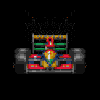miqi23 wrote:Care to explain what does it do then and how it's meant to work?
Page 2, Post #3
Vyssion wrote: ↑27 Feb 2017, 17:47
bhall II wrote:Now that I've seen the Williams version, I submit that T-wings reduce downforce coefficient at high speeds.
Ooooooooh!!!! I didnt see the little T wing there underneath!!! Yeah I would have to agree with you on what they do now I see that


Basically it will act as a flow conditioner for the rear wing... There might be some small amount of downforce produced by it, but very little given its size... It will generate two (at least) vortices (viewed from the
back of the F1 car) which will rotate clockwise on the right and anticlockwise on the left, essentially directing the air onto the pressure surface of the wing;
assuming the speed of the car and the shear interactions from the flow below it, when the car is on the straight, don't overpower it... If that happens, then you will get a type of vortex "sealing" effect where the rear wing's downforce, and by extension drag, will decrease at very high speeds.
* * * * * * * * * * * * * * * * * * * * * * * * * * * * * * * * * * * * * * * * * * * * * * * * * * * * * * * * * * * * * * * * * * * * * * * * * * *
In other news, I'm slowly cleaning up the Perrin F1 car model I mentioned I had... My OCD is getting the better of me though

APvortex723 wrote:Bhall, Vyssion, or anyone else ok with just a RW, shark fin and t-wing? I know its simplified but not overly wanting to model a full 2017 car to just get a general idea of whats going on.



